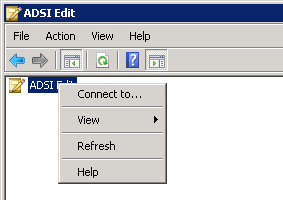The Exchange Server 2010 Edge Transport server role uses an instance of Active Directory Lightweight Directory Services (AD LDS) to store information about recipients and server configurations.
In some situations you may wish to connect to the AD LDS instance with ADSEdit.msc to view or make changes to data.
First you need to determine the port that the Exchange instance of AD LDS is running on. On the Edge Transport server open a command prompt and use the dbdsutil command to list the AD LDS instances.
C:\>dsdbutil dsdbutil: list instances Instance Name: MSExchange Long Name: MSExchange LDAP Port: 50389 SSL Port: 50636 Install folder: C:Windows Database file: C:Program FilesMicrosoftExchange ServerV14TransportRolesDataAdamadamntds.dit Log folder: C:Program FilesMicrosoftExchange ServerV14TransportRolesDataAdam Service state: Running
Next, launch ADSIEdit.msc, and open a new connection.

Set the naming context to Configuration and type in the server name (or localhost) followed by the port your AD LDS instance is running on.

Click OK to connect and you are now connected to the AD LDS instance being used by the Edge Transport server, and can view or modify the AD LDS data as necessary.



During the install of Exchange 2016 AD LDS is installed. How do I configure it afterwards?
Hi
I am in the process of designing site resiliency for Exchange 2010. Since the datacenters have fiber connections, it is preferred that we configure a stretched AD site across the 2 datacenters. since one datacenter will be primary, i would like to force the hub transport to use the edge roles in the primary site instead of round-robin connections to the edges in both datacenters. is there a way to force hub transport servers in site a to use the edge roles in site A and vice versa? your help would be greatly appreciated.
Stretching the AD site across both physical locations will reduce the overall resiliency of the solution.
Use separate AD sites.
Hi Paul,
In our exchange 2010 environment, we have 3 nodes under the database DAG. There is a mail box which was created in one node as active copy and the 2 passive copies were created in a single node. Below is the status output of the mailbox
——————————————————————————————-
[PS] C:Windowssystem32>Get-MailboxDatabaseCopyStatus -Identity H-MBX-9A
Name Status CopyQueue ReplayQueue LastInspectedLogTime ContentIndex
Length Length State
—- —— ——— ———– ——————– ————
H-MBX-9ADRTVSMHNT25 Suspended 213098 0 Failed
H-MBX-9ADRTVSMHNT25… Suspended 213098 0 Failed
H-MBX-9ATNHSRMBXN1 Dismounted 0 0 Healthy
—————————————————————————————————-
But the edb file in the DRTVSMHNT25 was deleted by mistake, now if we try to remove / reseed the mailbox from DRTVSMHNT25 or from TNHSRMBXN1 where the active copy was counted we are getting below error.
—————————————————————————————–
The operation couldn’t be performed because ‘H-MBX-9Adrtvsmhnt25’ matches multiple entries.
+ CategoryInfo : NotSpecified: (0:Int32) [Update-MailboxDatabaseCopy], ManagementObjectAmbiguousException
+ FullyQualifiedErrorId : 2717A9BF,Microsoft.Exchange.Management.SystemConfigurationTasks.UpdateDatabaseCopy
——————————————————————————————-
we had seen your article to remove it using ADSIEDIT. If we remove it using ADSIEDIT in DRTVSMHNT25 Domain Controller, will it reflect in the Domain Controller of TNHSRMBXN1 where the healthy copy was located?
If we delete will it give any issue for the exising database?
There are no users under that mailbox and we want to delete it.
Thanks,
R Sethunarayanan.
Hello,
Thank you, this article is very helpful.
Do you know where the recipients’ adresses are stored precisely? I cannot find them. Could they be stored in another naming context?
Thank you
Ok I found
They are hashed in LDAP://localhost:50389/OU=MSExchangeGateway